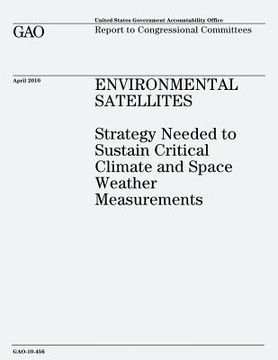Environmental Satellites: Strategy Needed to Sustain Critical Climate and Space Weather Measurements (in English)
Synopsis "Environmental Satellites: Strategy Needed to Sustain Critical Climate and Space Weather Measurements (in English)"
Environmental satellites provide data on the earth and its space environment that are used for forecasting the weather, measuring variations in climate over time, and predicting space weather. In planning for the next generation of these satellites, federal agencies originally sought to fulfill weather, climate, and space weather requirements. However, in 2006, federal agencies restructured two key satellite acquisitions, the National Polar-orbiting Operational Environmental Satellite System (NPOESS) and the Geostationary Operational Environmental Satellite-R series (GOES-R). This involved removing key climate and space weather instruments. GAO was asked to (1) assess plans for restoring the capabilities that were removed from the two key satellite acquisitions, (2) evaluate federal efforts to establish a strategy for the long-term provision of satellite-provided climate data, and (3) evaluate federal efforts to establish a strategy for the long-term provision of satellite-provided space weather data. To do so, GAO analyzed agency plans and reports. After key climate and space weather instruments were removed from the NPOESS and GOES-R programs in 2006, federal agencies decided to restore selected capabilities in the near term. However, neither the National Oceanic and Atmospheric Administration (NOAA) nor the Department of Defense (DOD) has established plans to restore the full set of NPOESS capabilities over the life of the program. Further, NOAA has not made any plans to restore the advanced climate capabilities of the instrument that was removed from GOES-R. Expected gaps in coverage for the instruments that were removed range from 1 to 11 years, and begin as soon as 2015. Until these capabilities are in place, the agencies will not be able to provide key environmental data that are important for sustaining climate and space weather measurements. For over a decade, federal agencies and the climate community have clamored for a national interagency strategy to coordinate agency priorities, budgets, and schedules for environmental satellite observations over the long-term - and the governance structure to implement that strategy. In mid-2009, a White House-sponsored interagency working group drafted a report that identifies and prioritizes near-term opportunities for environmental observations; however, the plan has not been approved by key entities within the Executive Office of the President and there is no schedule for finalizing it. In addition, the report does not address costs, schedules, or the long-term provision of satellite data, and there is no process or time frame for implementing it. Without a strategy for continuing environmental measurements over the coming decades and a means for implementing it, agencies will continue to independently pursue their immediate priorities on an ad hoc basis, the economic benefits of a coordinated approach to investments in earth observation may be lost, and our nation's ability to understand climate change may be limited. While federal agencies have taken steps to plan for continued space weather observations in the near-term, they lack a strategy for the long-term provision of space weather data. NOAA and DOD plan to replace aging satellites, and an interagency space weather program drafted two reports on how to mitigate the loss of key satellites and instruments. These reports were submitted to the Executive Office of the President's Office of Science and Technology Policy (OSTP) in the fall of 2009. Until OSTP approves and releases the reports, it will not be clear whether the reports provide a strategy to ensure the long-term provision of space weather data--or whether the current efforts are simply attempts to ensure short-term data continuity. Without a comprehensive long-term strategy for the provision of space weather data, agencies may make ad hoc decisions to ensure continuity in the near term and risk making inefficient investment decisions.

